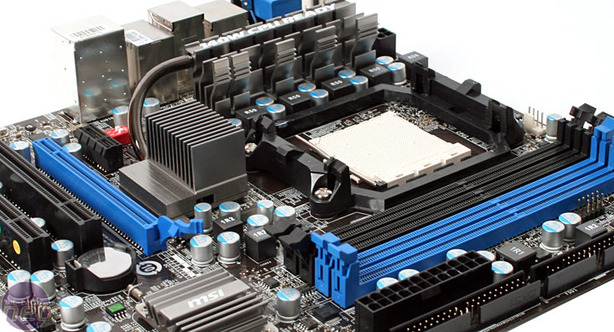
Power Consumption
Despite not using DrMOS MOSFETs, MSI does include 'Active Phase Switching' on its E65 that dynamically changes the amount of power phases in use by the CPU according to its load. In theory this makes it more efficient because it simultaneously keeps the MOSFETs in their most efficient load ranges and reduces the amount of hardware being used.The APS works a bit under idle - 2W - like we'd expect since here has the least power demands, although MSI doesn't really need it. It already beats the competition in efficiency by several Watts compared to the ECS and Gigabyte boards and over 10W compared to the Asus! Under load the ECS board matches it at 112W, but it saves nearly 20 per cent compared to the Gigabyte board, and 27 per cent versus the DDR2 Asus 780G from last generation. It's an excellent result for MSI.
Conclusion
This MSI motherboard performs exceptionally well at stock speeds, but was stressful to overclock. While it would boot and even attempt to run the tests, it wasn't be stable until we pulled right off the gas: we re-locked the fourth core, and it still didn't want to know, and eventually we ended up with stability just over 3GHz. That's a poor result, and it shows up in the overclocked performance tests.At £80, it's also a bit more expensive than the other 785G boards out there and given the choice available and that successful overclocking boards are available in its price bracket, the MSI doesn't look that desirable. The ECS A785GM-M Black Series motherboard is the otherside of this coin - it doesn't look particularly special, and doesn't have quite the appealing feature-set and BIOS, but it could hit 3.7GHz and break just a mild sweat. Unfortunately for both these boards, the Asus and Gigabyte solutions have the whole package, as well as a few quid on them too.
There is still a lot to like about the 785GM-E65. It looks great, it has plenty of extras features to use, it sips the juice from the wall and the BIOS is very easy to use. There are plenty of people looking for a highly efficient, well rounded board for using at stock speeds as a second/family PC or home theatre box.

It simply comes down to this: if you're uninterested in overclocking but you want a full fat and well working 785G motherboard, then the MSI 785GM-E65 should make your short list. If you do want to overclock and unlock cores to add value then avoid this board. There are still better options out there for that.
- Performance
- x
- x
- x
- x
- x
- x
- x
- x
- -
- -
- 8/10
- Features
- x
- x
- x
- x
- x
- x
- x
- x
- -
- -
- 8/10
- Value
- x
- x
- x
- x
- x
- x
- -
- -
- -
- -
- 6/10
- Overall
- x
- x
- x
- x
- x
- x
- x
- -
- -
- -
- 7/10

MSI MPG Velox 100R Chassis Review
October 14 2021 | 15:04








Want to comment? Please log in.